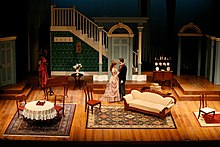Box set (theatre)
This article needs additional citations for verification. (October 2010) |


In theatre, a box set is a set with a proscenium arch stage and three walls. The proscenium opening is the fourth wall. Box sets create the illusion of an interior room on the stage, and are contrasted with earlier forms of sets which contained sliding flaps and gaps between set pieces.[1]
Box sets were introduced to the English theatre by Elizabeth Vestris. They were popularized by Marie Wilton at the Prince of Wales's Royal Theatre. They later became a feature of realist theatre, and an example of the "fourth wall removed" principle that characterized the work of noted realists such as Henrik Ibsen's A Doll's House, George Bernard Shaw's Pygmalion, and Anton Chekhov's The Seagull.[2]
In the play style of realism, the box set of the stage was a room with either a plain black backdrop or three walls. The fourth wall was invisible, separating the characters from the audience, and the ceiling was tilted down at the far end of the stage and up toward the audience. Doors slammed instead of swinging when being shut, as in reality.
References
- ^ "box set (theatre)". Encyclopædia Britannica. Encyclopædia Britannica, Inc. 2009. Retrieved 22 December 2009.
- ^ Nineteenth-century theatrical scenery
